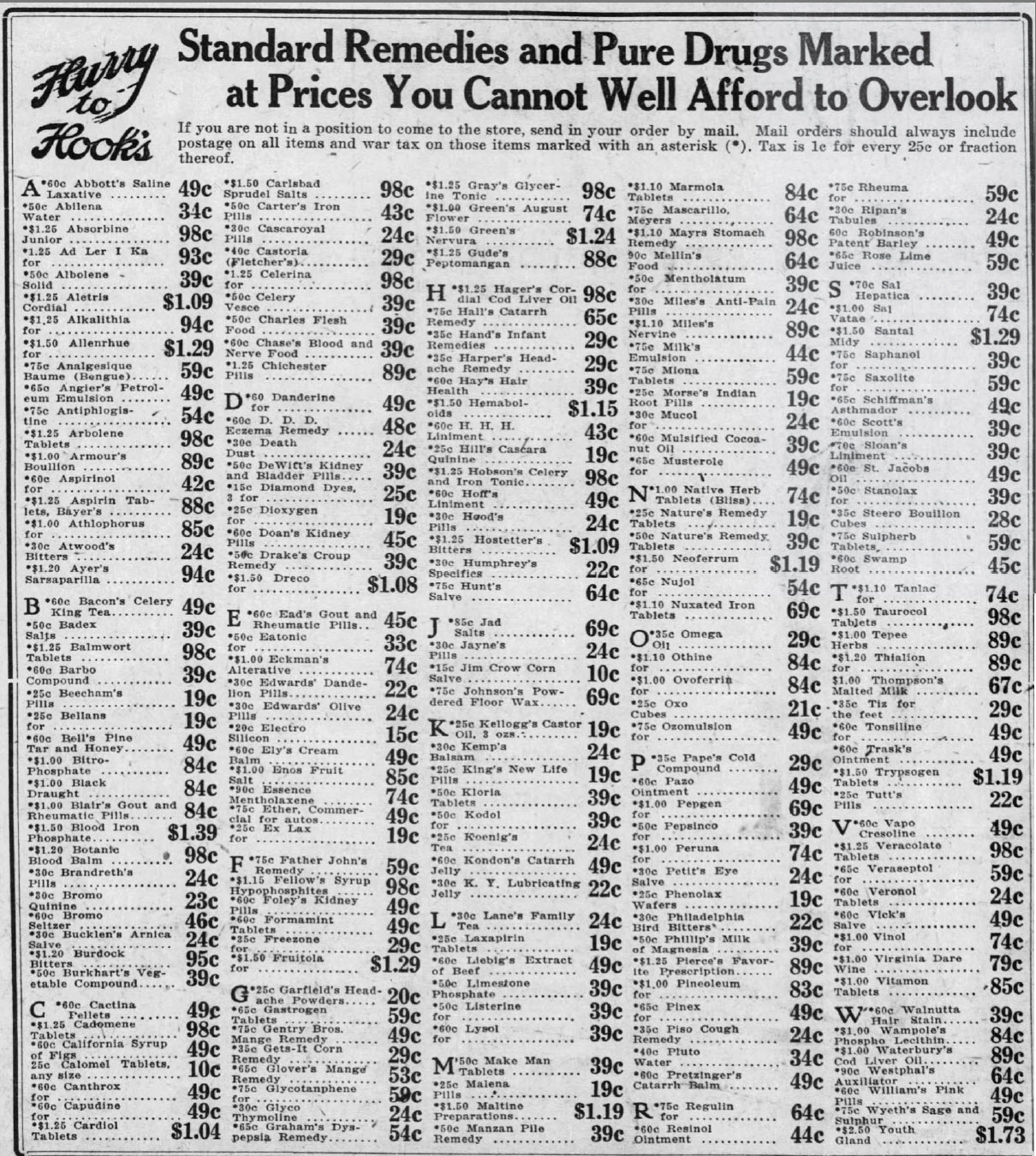So how many over the counter “medicines” could have killed you in the early 20th Century? A lot. I found this amazing ad for Hook’s Pharmacy in Muncie, Indiana (1921) while researching. Take a gander. Recognize any of the products listed?

Not a lot, right? For the most part, I had no clue what these items were. Bombastically vague product names seemed to be in vogue at the time. I looked them all up (because, of course I did) and found that most of those listed are what we consider patent medicines, and they fall into four major categories (potentially deadly ones have an asterisk after the name):
- All Purpose Pep and Vigor Restorers:
- Botanic Blood Balm – Promised positive and permanent relief from “blood poison,” and to quickly cure “old ulcers, scrofula, eczema, itching skin and blood humors, cancer, festering sores, boils, carbuncles, pimples or offensive eruptions, pains in bones or joints, rheumatism, catarrh, or any blood or skin trouble,” as well as “female weakness” and “hereditary taint.”
- Gude’s Peptomangan – To provide a direct supply of minerals; to help build hemoglobin in the blood and stimulate the appetite so that more iron is absorbed from food
- Make Man Tablets* – For those who are “nervous, tired, irritable, don’t sleep good, wake up every morning with a bad taste in your mouth and a dull, hot, tired feeling in your head”. Splendid tonic, blood purifier, and nerve strengthener. (the main ingredients were arsenic and strychnine – yay!).
- Morse’s Indian Root Pills – Its manufacturer claimed the pills contained herbal ingredients that would help “cleanse the blood,” as “impurity of the blood” was believed to be the cause of all disease.
- Wampole’s Phospho Lecithin* – for Nervous Prostration, Nerve Exhaustion, Nervous Excitement, Hysteria, etc. (with strychnine – yay!)
- William’s Pink Pills for Pale People – Claimed to cure chorea, referenced frequently in newspaper headlines as “St. Vitus’ Dance,” as well as “locomotor ataxia, partial paralyxia, seistica, neuralgia rheumatism, nervous headache, the after-effects of la grippe, palpitation of the heart, pale and sallow complexions, [and] all forms of weakness in male or female.”
- Youth Gland – “Cured” extra strain on the gland tissues brought on by sickness, age, worry or overwork.
- Laxatives and Digestives
- Carlsbad Sprudel Salts – Mineral salts used for gastric irrigation taken by mouth and through enemas
- Cascaroyal Pills – Blackburn’s Casca Royal Pills treat the bowels wisely and well, a rational physic and stomachic relieve constipation
- Eatonic – For flatulence and bloating
- Edward’s Dandelion Pills – “Purely vegetable tonic and cathartic” “For constipation, liver and kidney diseases, scrofulous affections and all diseases of the stomach and bowels”.
- Green’s August Flower – Dyspepsia
- Pluto Water – strongly laxative natural water product which was very popular in the United States in the early 20th century.
- Sal Hepatica – mineral salt laxative that was produced and marketed by Bristol-Myers from its inception in 1887, becoming its first nationally recognized product in 1903, until 1958. When dissolved in water, it was said to reproduce the taste and effect of the natural mineral waters of Bohemia.
- Vanity
- Albolene Solid – Facial Cleanser
- Canthrox – a granular shampoo marketed to prevent dandruff, falling hair, and graying.
- Charles Flesh Food – Beautifier ointment that “builds firm healthy flesh”
- Westphal’s Auxiliator – Hair tonic (with a terrible name)
- Wyeth’s Sage and Sulphur – Hair tonic that contained sulphur, lead acetate, glycerine, and cayenne pepper (but not sage).
- General Weirdness and Outright Quackery
- Alkalithia*-Trade name of an effervescent mixture containing lithium (yay!); employed in the rheumatic and gouty
- Death Dust – Insecticide (This wins for best name, imo. Surprisingly, it wasn’t deadly to humans since it likely only contained borax and pyrethrum – made from dried chrysanthemums).
- Ozomulsion – “Cure” for consumption (tuberculosis) (Right…)
- Schiffman’s Asthmador* –To relieve the distress of bronchial asthmatic paroxysms (with belladonna – yay!)
- Philadelphia Bird Bitters – Medicine for sick birds – just like it says (???)
- Trypsogen Tablets – Diabetes remedy said to contain “the enzyme of the islands of Langerhans with the tryptic and amylolystic ferments of the pancreas” (???)
- Vapo Cresoline – Vaporizing lamp supposed to cure “Whooping Cough, Spasmodic Croup, Nasal Catarrh, Colds, Bronchitis, Coughs, Sore Throat, Broncho [sic] Pneumonia, The Paroxysms of Asthma and Hay Fever, The Bronchial Complications of Scarlet Fever and Measles and as an aid in the treatment of Diphtheria and Certain Inflammatory Throat Diseases.” (Of course, it did none of those things.)
If you’re tempted to think of the past as some sort of glorious “simpler” time, chew on this – the first two categories of patent drugs above had flourishing sales due to the poor diet of the time – lots of iron deficiency, anemia, and constipation among the general population. Fun! And several of those “medicines” could outright kill you while they claimed to solve such problems. One in the ad just might kill a character in the 3rd book in my Viv and Charlie Mystery Series. (Of course, I’m not going to tell you which medicine. Where’s the fun in that?)
Patent medicines went the way of the dodo in the late 1930s due to more stringent food and drug acts passed by the US government. It’s for the best, but I still think it’s fascinating all the potentially deadly stuff you could’ve purchased at the local drugstore in 1921. And if you’re like me, it certainly makes knocking off that troublesome character in your latest book a lot easier…
